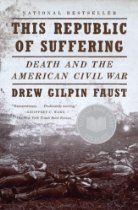When Barack Obama delivered his victory speech on a mild Chicago night last November, he reminded his supporters that the election was not the endpoint. “This victory alone is not the change we seek. It is only the chance for us to make that change. And that cannot happen if we go back to the way things were,” he said. “It can’t happen without you, without a new spirit of service, a new spirit of sacrifice.” It was not the first time Obama had evoked the concept of sacrifice — nor was it to be the last. The language of sacrifice and service was central to his campaign, and it has been a key aspect of the tone he has set ever since.
As the financial crisis deepens, other leaders have begun echoing Obama. When New York governor David Paterson recently proposed cutting state employee benefits, he argued that trying times require adjusted expectations: “We’ve made too many promises and asked for too few sacrifices. We’re going to have to change our culture as we know it.” Iowa governor Chet Culver has likewise observed, “We are all facing this challenge together. And together, we must accept the reality and share in the sacrifice.”
Obama casts the spirit of sacrifice as new — so new, in fact, that it doesn’t exist yet. In his formulation, as in those of Paterson and Culver, it exists in the future as a psychology we need to invent if the U.S. is to survive as a nation. But when it comes to American history, sacrifice has long been a unifying ideal in times of crisis — and it has also long been a concept that government has used to enlarge its scope. Indeed, the story of how the once-lean federal government has grown — and grown and grown — is closely connected to the story of how sacrifice was anointed as the ultimate form of national service.
That story is the subject of This Republic of Suffering: Death and the American Civil War, the stunning and thought-provoking National Book Award finalist from Drew Gilpin Faust. Currently president of Harvard University, Faust is a historian of the American nineteenth century, specializing in the antebellum South and the Civil War. Ten years in the writing, This Republic of Suffering represents the culmination of a career spent studying a pivotal moment in the nation’s past. A finalist for the 2008 National Book Award and a prominent title on last year’s lists of best books, Faust’s study possesses that signal virtue of the finest works of history: This Republic of Suffering not only illuminates the past, but it also sheds light on the present.
During the Civil War, Faust argues, “sacrifice and the state became inextricably intertwined.” The 620,000 soldiers who died during the Civil War form the subject of her book, which explains not only how officers and troops faced death, but how families — and eventually government — responded to the increasingly unfathomable carnage brought about by a war defined by modern weaponry, epidemic disease and unanticipated length.
More Americans died in the Civil War, Faust notes, “than in the Revolutionary War, the War of 1812, the Mexican War, the Spanish-American War, World War I, World War II and the Korean War combined.” Two percent of the United States’ population — the equivalent of six million today — perished during a conflict many originally thought would be resolved in a matter of weeks. About half of those who died did so as “unknown soldiers.” But these numbers are only approximate. Neither the North nor the South kept accurate records of casualties, nor did they reliably inform families of loved ones’ fates. Precise recordkeeping was no one’s job. And in a conflict where a single day of battle could leave thousands dead and wounded, transport and burial were huge problems. There was no system for identifying or counting the dead, nor was there an established mechanism for conveying bodies to their families. Mass, unmarked graves were commonplace. Many were left to die — and to rot — on the battlefields where they fell.
United We Fall
At once unusually brutal and staggeringly mundane, death was a unifying experience during an otherwise intensely divisive and destructive war. No family escaped from the war’s toll; while it divided the country politically and geographically, it nevertheless brought people together through the shared experience of loss. Faust tells moving stories of how civilians and soldiers alike cooperated across enemy lines to help families locate missing relatives, writing letters and even placing ads in newspapers. She also describes the entrepreneurial energy that surrounded the war’s heavy death toll.
Entire cottage industries arose in response to the public’s urgent need to know their family members’ fates — and to give the fallen a proper burial. There were private agents for locating missing soldiers, and transport companies dedicated to conveying the dead to their families (one even marketed fancy refrigerated coffins for the long ride home). Undertakers established the art of embalming during this period, as people were willing to pay a premium to see the deceased looking as lifelike and fresh as possible. A morbid tourist industry grew up around battlefields, where civilians flocked to pick their way among the slain looking for loved ones but also for loot, information and thrills.
Faust notes that “the rhetoric of service … rationalized the violence of this devastating war by casting it as the instrument of both nationalist and Christian imperative.” She also notes that when it was all over, the sheer symbolic weight of the dead posed a unique set of obligations for a state that had leveraged that service — and the sacrifice it entailed — in the name of human rights. The Civil War was a different sort of war. It centered on a profound philosophical struggle about the meaning of personhood, the reach of citizenship, the inherent value of human life and the basic freedom that all people should share. These things posed a problem for the government’s callous — if entirely conventional — disregard for soldiers’ fates. As the war went on, the contrast between the war’s humanist rationale and its inhumane practices compelled the state to try to make amends for treating those who fought as anonymous, expendable parts of a colossal national war machine.
Abraham Lincoln’s Gettysburg address is usually remembered for its stirring evocation of liberty at the height of the Union’s campaign against slavery. Delivered in November 1863, a few months after the Union’s decisive victory at Gettysburg, Lincoln defined the war as a struggle to affirm the founding American principle that “all men are created equal,” declaring that the sacrifice of those who died to end slavery was giving the nation “a new birth of freedom.” But Faust reminds us that slavery was not the only thing on Lincoln’s mind. Lincoln was also thinking about the soldiers who fought and died to end the “peculiar institution.”
What Gettysburg Means
The Battle of Gettysburg produced more casualties than any other battle in the war. When it was all over, more than 57,000 Union and Confederate troops were wounded, dead, captured, or missing. Almost 8,000 lay dead on the battlefield, along with more than 3,000 horses. While the horses’ bodies were burned, unburied human corpses decomposed in the summer heat, polluting the air and sickening the locals. Four months later, Gettysburg became the site of the Soldiers’ National Cemetery. Lincoln’s famous address, delivered at the cemetery’s dedication, assigned meaning to the carnage that had taken place at Gettysburg. So did the design of the cemetery itself. Arranged in semicircles around a central monument, thousands of uniformly-sized white markers gave every death a place within a larger national plan. Each death was equally important; all were oriented around the towering, unifying American ideal of equality.
The opening of the Soldiers’ National Cemetery marked the federal government’s entry into the funeral business — and into the symbolic and practical work of mourning. The first of its kind, the cemetery was an early gesture in what became a massive effort of state-sponsored accounting, identifying, interring and memorializing that went on long after the war’s end. By 1864, new laws established rules for tracking casualties and registering graves. And once the war was over, the state undertook the difficult and costly work of retroactively creating records of the dead. Dedicated civil servants scoured the countryside to find and count Union corpses, identifying and burying them along the way. When it became clear that the southern graves of Northern soldiers were not safe from desecration, the state also funded the work of exhuming, transporting and reburying Union corpses in national cemeteries like the one at Gettysburg. Along the way, the government assumed a primary stake in the traditionally private work of honoring the dead.
The effort was huge and unprecedented. By the time it was completed in 1871, more than 300,000 Union soldiers had been interred in 74 national cemeteries at a cost of $4,000,306.26 (or about $72 million today). The effort was also transformative. The Civil War-era “republic of suffering” — as one observer called it — had begotten an immense governmental bureaucracy whose size was justified by its humanitarian ends. Edmund Whitman, one of the principal architects of the post-war reburial effort, noted: “Such a consecration of a nation’s power and resources to a sentiment, the world has never witnessed.”
The new memorial bureaucracy set the terms for how we have treated American soldiers ever since. Dog tags — in use since World War I –now ensure that every soldier is carrying virtually indestructible ID. Veterans receive a range of benefits and services. And the United States currently spends more than $100 million every year trying to locate the 88,000 men who were lost in World War II, Korea and Vietnam, and have yet to be found.
Less obviously, but perhaps even more profoundly, the post-war memorial bureaucracy also set the stage for a major redefinition of federal government. According to Faust, the government’s felt obligation to the dead formed the basis for the expansion of federal power that has become the hallmark of modern America. Sacrifice and service, she shows, were the watchwords of our nation’s first, decisive push toward big government; enormous increases in federal spending and a growing bureaucracy were the means. “Obligated by the sacrifices of its dead,” Faust observes, “the United States’ new and elevated destiny became bound up with the nation itself: its growing power, its wealth, its extent, its influence.”
Faust treads lightly here, and, like the judicious historian she is, avoids drawing explicit connections to the present. Still, in the year since This Republic of Suffering was published, the book has acquired a sharply contemporary resonance. Faust shows us how the Civil War facilitated the rise of big government via a state-sponsored ethic of sacrificial service. Today, the language of sacrifice and service is making a comeback — and is doing so right alongside one of the biggest governmental expansions in U.S. history. As we watch elected officials wield the language of sacrifice and service while spending hundreds of billions trying to bail out businesses and stimulate the economy, we can reflect on the long history of our present moment. After all, reflection is free. Unfortunately, lack of historical perspective is not. As the government mortgages children’s futures to pay for its own massive enlargement, we might well wonder who is sacrificing for whom — and what end that sacrifice will ultimately serve.



